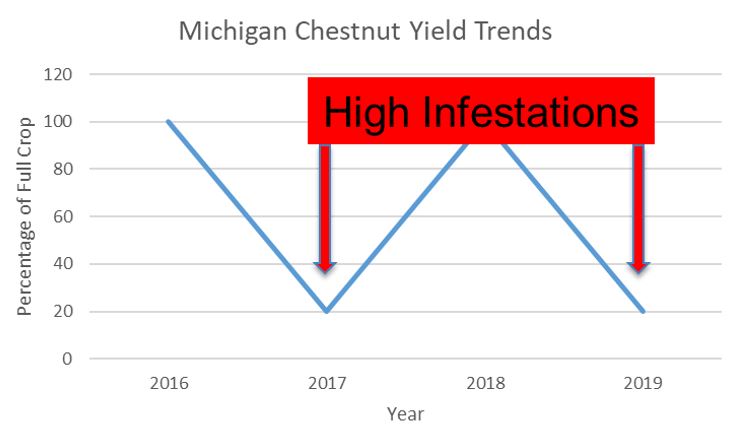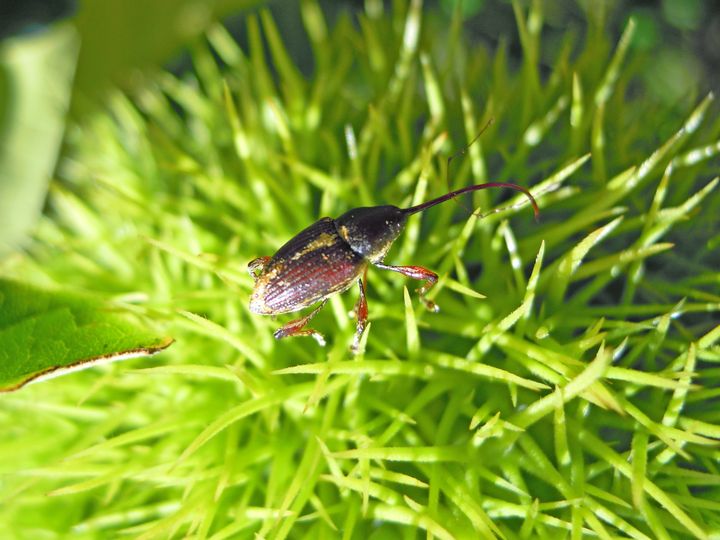Managing chestnut weevil in Michigan in 2020
Chestnut growers need to scout for this potentially damaging pest this season.

The most important insect pest of chestnut in the central-eastern United States is the lesser chestnut weevil (Curculio sayi). Large chestnut weevil (C. caryatrypes) is also an important pest but is less prevalent. Large and lesser chestnut weevil are native to North America and are host-specific, only infesting tree species in the genus Castanea, including American chestnut, Chinese chestnut, European chestnut and chinquapin.
Large and lesser chestnut weevil both lay eggs on developing nuts with developing larvae feeding on and compromising the kernel. If left unchecked, the larvae can infest and destroy the nuts. Larvae can be present at harvest resulting in “wormy” nuts making their way to consumers.
Over the last few years, Michigan chestnut producers have reported an increase in the number of larvae in nuts at harvest. It is likely that the observed larvae are immature chestnut weevils, though the exact weevil species has not been identified. As an emerging issue, Michigan producers have had very little experience with chestnut weevil and no formal research has been done on this pest in Michigan. However, based on field observations in Michigan and research out of Kentucky and Missouri, we can make some educated estimations about chestnut weevil biology and management in Michigan.
During 2017 and 2019, some farms experienced high levels of weevil infestation at harvest. Affected orchards can be heavily infested, while other farms have effectively no larvae in nuts at harvest. At this time, chestnut weevil populations appear to be localized and cyclic in Michigan, with higher infestation percentages coinciding with low-yield crops, which generally occur on a biannual basis.

Life cycle
It is important to understand the biology of chestnut weevil to effectively monitor and manage it on the farm. Lesser chestnut weevil adults likely emerge during two separate periods in spring around bloom (May-June) and early fall before burrs open (September-October). Spring populations feed on catkins while they are available. Once the catkins decline, the population disappears. It is unknown if they return to the soil or feed on other plants.
Eggs are deposited in the downy lining surrounding the nut as burs open and hatch in approximately 10 days, at which time the larvae feeds on the kernel and develops within the shell. After two to three weeks, the larvae chew a small exit hole and drop to the soil. Most overwinter as larvae, pupate in the soil the following fall and overwinter as adults. The total lifecycle is completed in two to three years.
Large chestnut weevil adults likely emerge in August-September and begin laying eggs in immature burrs almost immediately (well before lesser chestnut weevil begin laying eggs). Eggs hatch in five to seven days and the larvae feed and develop within the nut for two to three weeks. The larvae usually exit the chestnut before the nuts drop to the ground, overwintering in the soil. Pupation and adult emergence take place the following summer. A small population of larvae may overwinter a second winter before pupation. The total lifecycle is completed in one to two years.

Identification and detection
Lesser and large chestnut weevils both have robust bodies, long snouts and are dark brown or tan with brown mottling or stripes. Lesser chestnut weevil is 0.25 inch in length, with a snout of equal or greater length. The body of large chestnut weevils is 0.375 inches long and the snout is 0.375-0.625 inches long.
Scouting for adult weevils should begin just before bloom and continue regularly until harvest. At this time, effective passive trapping techniques for chestnut weevil have not been identified; you should instead focus on the limb-tapping technique. To use the limb-tapping technique, place a light-colored sheet under the limb you are sampling and tap the branch with a padded pole or stick; tap gently to avoid damage to the tree. Jarring the branch causes the weevils to drop from the tree onto the sheet. Weevils will “play dead” when disturbed, so don’t be fooled.
Chestnut weevils are substantial in size and should be easily visible if present. Sample at least 30 branches per acre. Scouting locations should include both the edges and interior of orchards as well as any known hotspots.
Management
There are two primary goals in managing chestnut weevil. The first goal is to prevent larvae in nuts at harvest making their way to consumers; the second goal is to prevent nut damage from feeding. The four weeks prior to harvest are the most critical time for management, as eggs laid during that timeframe can result in larvae in the nuts at harvest. There are chemical, cultural and postharvest treatments available to control chestnut weevils. Ideally, a combination of cultural and chemical management techniques would effectively control the weevil in the field and eliminate the need for postharvest heat treatments, which can diminish quality and the marketable yield.
Cultural control through sanitation is the first step in managing chestnut weevil. Collecting and destroying nuts that won’t be harvested just after they drop can remove some developing larvae from the orchard. Insecticides should target the later windows of potential adult activity; August-September for large chestnut weevil adult emergence, and September-October for lesser chestnut weevil adult emergence. Do not apply insecticides during adult activity in May-June as bees are often foraging in the orchard at this time. Applying insecticide should only be made in response to significant weevil pressure and positive identification.
There are a number of factors to consider when selecting an insecticide for weevil control, including relative efficacy against other relevant pests like scarabs and leafhopper, known weevil efficacy in other crops, toxicity to beneficials, mode of action, preharvest interval and the number of applications allowed per season. Based on pest biology, the most critical applications for preventing larvae in the nuts at harvest occur in the four weeks before harvest and target adult weevils to prevent egglaying. Once larvae enter the kernels, insecticides will be ineffective. Chemical control for the entire period of kernel development will more thoroughly prevent damage, but may not be economically practical unless the orchard has experienced substantial weevil crop losses in the past.
The table below includes the likely best candidates for chestnut weevil management in Michigan based on the selection criteria previously described. Use a minimum of two modes of action in rotation to prevent resistance development. Using pyrethroids late in the season may also be considered. Using pyrethroids in the early to mid-growing season is not recommended as it can result in increased pest mite populations.
For a complete list of registered pesticides, see the Michigan Chestnut Management Guide.
Well-timed applications, good sanitation practices and persistent scouting are the key to successful chestnut weevil management in Michigan. There is still a lot to learn about the prevalence and activity of chestnut weevil in Michigan. As we learn about the biology of this pest and the efficacy of various insecticides, management recommendations will likely improve.
|
Selected pesticides for chestnut weevil management, 2020 | |||||||||||||||
|---|---|---|---|---|---|---|---|---|---|---|---|---|---|---|---|
|
Active ingredient |
Products labeled |
Pesticide efficacy |
Beneficial insect toxicity |
Per acre rates |
Max. applications per season |
Application interval min. |
Days of control |
Preharvest intervals |
Notes | ||||||
|
Potato leafhopper |
Scarabs |
Plum curculio |
Bees |
Mite predators |
Insect predators |
Fruit |
Chestnut |
Seasonal max. | |||||||
|
Phosmet (1B) |
Imidan 70W |
Good-Excellent |
Excellent |
Excellent |
Toxic |
Safe |
Moderate |
2.125 lbs |
4.3-8.5 lbs |
17.14 lbs |
2-3 |
--- |
3-10 days |
28 days |
Imidan is an organophosphate insecticide and provides good broad-spectrum control of many pests in Michigan. |
|
Carbaryl (1A) |
Sevin 4F |
Excellent |
Good-Excellent |
Good |
Toxic |
Toxic |
Toxic |
2-3 qts |
4-5 qts |
15 qts |
4 |
7 days |
3-10 days |
14 days |
Sevin is an organophosphate insecticide and provides good broad-spectrum control of many pests in Michigan. |
|
Acetamiprid (4A) |
Assail 30SG |
Excellent |
Excellent |
Excellent |
Moderate |
Safe |
Moderate |
2.3-3.4 oz |
4.1 oz |
16.4 oz |
4 |
14 days |
7 days |
14 days |
Targets aphids, leafhoppers, leafminers, Japanese beetles, plum curculio and some lepidopteran pests. This translaminar (locally systemic) material has a long residual inside the plant. |
|
Clothianidin (4A) |
Belay |
Excellent |
Excellent |
Excellent |
Moderate |
Safe |
Moderate |
6 fl oz |
3-6 fl oz |
12 fl oz |
2 |
10 days |
7 days |
21 days |
Targets aphids, leafhoppers, leafminers, curculio, Japanese beetles and lepidopteran pests. As a foliar spray, Belay is a translaminar (locally systemic) material and has a long residual inside the plant. |
Pesticide efficacy and beneficial insect toxicity is based on trials in fruit crops with products containing the same active ingredient, as reported in the E154 Fruit Management Guide, Michigan State University Extension.
This work is supported by the Crop Protection and Pest Management Program 2017-70006-27175 from the USDA National Institute of Food and Agriculture. Any opinions, findings, conclusions or recommendations expressed in this publication are those of the author(s) and do not necessarily reflect the view of the U.S. Department of Agriculture.



 Print
Print Email
Email



